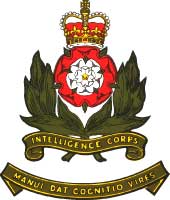
The 1st Division is an active division of the British Army that has been formed and disestablished numerous times between 1809 and the present. In its original incarnation as the 1st Division, it took part in the Peninsular War—part of the Coalition Wars of the Napoleonic Wars—and was disbanded in 1814 but was re-formed the following year for service in the War of the Seventh Coalition and fought at the Battle of Waterloo. It remained active as part of the British occupation of France until it was disbanded in 1818, when the British military withdrew. The division was then raised as needed; it served in the Crimean War, the Anglo-Zulu War, and the Second Boer War. In 1902, the British Army formed several permanent divisions, which included the 1st Division, which fought in the First World War, made various deployments during the interwar period, and took part in the Second World War when it was known as the 1st Infantry Division.

The Highlanders, 4th Battalion, Royal Regiment of Scotland is an infantry battalion of the Royal Regiment of Scotland.

The 1st Armoured Infantry Brigade was an infantry brigade of the British Army with a long history including service during both the First and the Second World Wars. It was based at Tidworth Camp. Previously, it has been designated 1st (Guards) Brigade, 1st Infantry Brigade, 1st Mechanised Brigade, and under the initial Army 2020 reforms assumed the title of 1st Armoured Infantry Brigade. Under the Future Soldier programme, the brigade merged with the 1st Artillery Brigade to form the 1st Deep Recce Strike Brigade Combat Team.

The 11th Security Force Assistance Brigade is a brigade of the British Army which is intended to train and assist foreign forces. In 2021, under the Future Army changes, the brigade was redesignated, formerly being the 11th Infantry Brigade & HQ South East. Prior to the Army 2020 changes in 2013, the brigade was temporarily activated for deployment to Afghanistan. Originally formed in the Second Boer War, the brigade was engaged during both World Wars.
This is the Operation Herrick ground order of battle, which lists any British ground forces that have taken part in the duration of Operation Herrick between 2002 and 2014.
Army 2020 Refine was the name given to the restructuring of the British Army in the mid-to-late 2010s, in light of the Strategic Defence and Security Review 2015. As its name suggests, it was a "refinement" of Army 2020, an early 2010s reorganisation of the Army to be completed by 2020, originally conducted in light of the Strategic Defence and Security Review 2010.
Army 2020 was the name given to the restructuring of the British Army in the early and mid-2010s, in light of the Strategic Defence and Security Review 2010. The plan, as its name suggested, was intended to be completed by 2020, though most of its reorganisations were completed by the middle of the decade. It was succeeded by Army 2020 Refine, a series of new changes and refinements of Army 2020's restructuring, conducted in light of the Strategic Defence and Security Review 2015.
21 Engineer Regiment is a regiment of the British Army's Royal Engineers. It is currently based at Claro Barracks, Ripon, North Yorkshire.
32 Engineer Regiment is a regiment of the British Army's Royal Engineers.
The 4th Military Intelligence Battalion is a military intelligence unit of the British Army's Intelligence Corps, which provides close intelligence support to the headquarters for the only warfighting division in the army.

The 1st Military Police Brigade is a policing formation of the British Army, which is the only one-star command of the Royal Military Police. The brigade was formed in 2014 and is commanded by a brigadier, but is due to be re-structured and reduced to a colonel's command.

The page contains the current structure of the British Army. The British Army is currently being reorganised to the Future Soldier structure.
The following is a hierarchical outline for the structure of the British Army in 1989. The most authoritative source for this type of information available is Ministry of Defence, Master Order of Battle, and United Kingdom Land Forces, HQ UKLF, UKLF ORBAT Review Action Plan, HQ UKLF, 1990.

The 1st Aviation Brigade Combat Team is an aviation formation of the British Army. Most of its units are from the Army Air Corps (AAC). It was stood up on 1 April 2020 by combining the Wattisham Flying Station Headquarters, formerly the Attack Helicopter Force (AHF) at Wattisham and the Aviation Reconnaissance Force at the Royal Naval Air Station Yeovilton. It reached initial operating capability on 1 April 2021 and full operating capability on 1 January 2023.

5 Military Intelligence Battalion is an Intelligence Corps Army Reserve unit in the British Army. It is based in Scotland, with sub-units in Edinburgh, Gateshead and Leeds and detachments in Glasgow and Chesterfield. It is partnered with 1 Military Intelligence Battalion, a Regular Army unit based in Catterick Garrison, North Yorkshire.
3 Armoured Close Support Battalion REME is a battalion of the Royal Electrical and Mechanical Engineers of the British Army.
6 Armoured Close Support Battalion REME is a battalion of the Royal Electrical and Mechanical Engineers of the British Army.
The 7th Battalion, The Rifles is an Army Reserve battalion of the British Army originally formed from elements of the Royal Rifle Volunteers, and Royal Green Jacket badged Sub-Units of The London Regiment following the Future Army Structure programme, and remains an integral part of the regiment.
Future Soldier is a reform of the British Army resulting from the Integrated Review of Security, Defence, Development and Foreign Policy published in March 2021. The aim of the reform is to create a more lethal, agile and expeditionary force, able to fight and win wars and to operate in the grey-zone between peace and war. Future Soldier was published on 25 November 2021 and deals with the organizational changes of the British Army, with changes to personnel and equipment were set out in the Defence in a Competitive Age paper published on 22 March 2021.

The 1st Regiment, Royal Military Police is a military policing unit of the British Army which was formed during the height of the Troubles in Northern Ireland in the 1970s, but disbanded in 1985 following cuts to the RMP in the region. The regiment was then reformed in 1996 following the Options for Change, and since 2014 has been an integral part of the 1st Military Police Brigade and just one of the two remaining RMP regiments since 2019.









